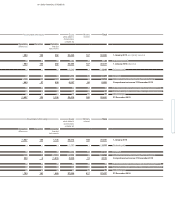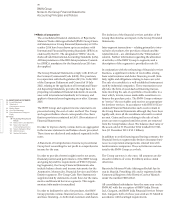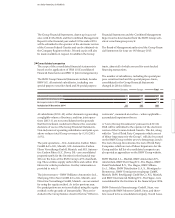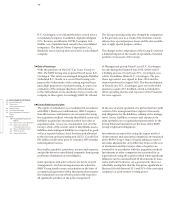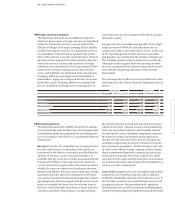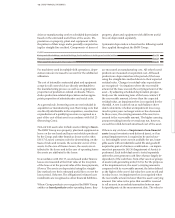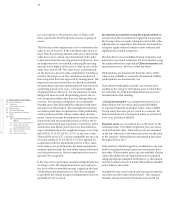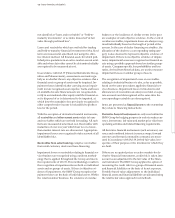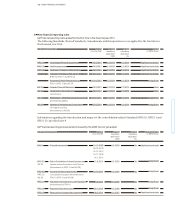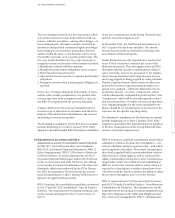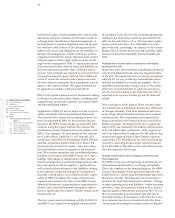BMW 2014 Annual Report Download - page 105
Download and view the complete annual report
Please find page 105 of the 2014 BMW annual report below. You can navigate through the pages in the report by either clicking on the pages listed below, or by using the keyword search tool below to find specific information within the annual report.
105 GROUP FINANCIAL STATEMENTS
not classified as “loans and receivables” or “held-to-
maturity investments” or as items measured “at fair
value through profit and loss”.
Loans and receivables which are not held for trading
and held-to-maturity financial investments with a fixed
term are measured at amortised cost using the effec-
tive
interest method. All financial assets for which pub-
lished price quotations in an active market are not avail-
able and whose fair value cannot be determined reliably
are required to be measured at cost.
In accordance with IAS 39 (Financial Instruments: Recog-
nition
and Measurement), assessments are made regu-
larly as to whether there is any objective evidence that a
financial asset or group of assets may be impaired. Im-
pairment losses identified after carrying out an impair-
ment test are recognised as an expense. Gains and losses
on available-for-sale financial assets are recognised di-
rectly in accumulated other equity until the financial
as-
set is disposed of or is determined to be impaired, at
which time the cumulative loss previously recognised in
other comprehensive income is reclassified to profit or
loss for the period.
With the exception of derivative financial instruments,
all receivables and other current assets relate to loans
and receivables which are not held for trading. All such
items are measured at amortised cost. Receivables with
maturities of over one year which bear no or a lower-
than-market interest rate are discounted. Appropriate
impairment losses are recognised to take account of all
identifiable risks.
Receivables from sales financing comprise receivables
from retail customer, dealer and lease financing.
Impairment losses on receivables relating to financial ser-
vices
business are recognised using a uniform method-
ology that is applied throughout the Group and meets
the requirements of IAS 39. This methodology results in
the recognition of impairment losses both on individual
assets and on groups of assets. If there is objective evi-
dence
of impairment, the BMW Group recognises
im-
pairment losses on the basis of individual assets. Within
the retail customer business, the existence of overdue
balances or the incidence of similar events in the past
are examples of such objective evidence. In the event of
overdue receivables, impairment losses are always recog-
nised individually based on the length of period of the
arrears. In the case of dealer financing receivables, the
allocation of the dealer to a corresponding rating
cate-
gory is also deemed to represent objective evidence of
impairment. If there is no objective evidence of impair-
ment, impairment losses are recognised on financial as-
sets using a portfolio approach based on similar groups
of assets. Company-specific loss probabilities and loss
ratios, derived from historical data, are used to measure
impairment losses on similar groups of assets.
The recognition of impairment losses on receivables
relating to industrial business is also, as far as possible,
based on the same procedures applied to financial
ser-
vices business. Impairment losses (write-downs and
allowances) on receivables are always recorded on sepa-
rate
accounts and derecognised at the same time
the
corresponding receivables are derecognised.
Items are presented as financial assets to the extent that
they relate to financing transactions.
Derivative financial instruments are only used within the
BMW Group for hedging purposes in order to reduce cur-
rency, interest rate, fair value and market price risks from
operating activities and related financing requirements.
All derivative financial instruments (such as interest, cur-
rency
and combined interest / currency swaps, forward
currency and forward commodity contracts) are meas-
ured in accordance with IAS 39 at their fair value, irre-
spective of their purpose or the intention for which they
are held.
If there are no quoted prices on active markets for de-
rivative
financial instruments, credit risk is taken into
account as an adjustment to the fair value of the finan-
cial instrument. The BMW Group applies the option of
measuring the credit risk for a group of financial assets
and financial liabilities on the basis of its net exposure.
Portfolio-based value adjustments to the individual
finan cial assets and financial liabilities are allocated using
the relative fair value approach (net method).




